Ijraset Journal For Research in Applied Science and Engineering Technology
- Home / Ijraset
- On This Page
- Abstract
- Introduction
- Conclusion
- References
- Copyright
Dynamic Analysis on RCC and Composite Structure for Uniform and Optimized Section
Authors: Ankit Kumar, Dr. Savita Maru
DOI Link: https://doi.org/10.22214/ijraset.2021.39503
Certificate: View Certificate
Abstract
This study examines the composite structure that is increasing commonly in developing countries. For medium-rise to high-rise building construction, RCC structures is no longer economical due to heavy dead weight, limited span, low natural frequency and hazardous formwork. The majority of commercial buildings are designed and constructed with reinforced concrete, which largely depends on the existence of the constituent materials as well as the quality of the necessary construction skills, and including the usefulness of design standards. Conventional RCC structure is not preferred nowadays for high rise structure. However, composite construction, is a recent development in the construction industry. Concrete-steel composite structures are now very popular due to some outstanding advantages over conventional concrete and steel structures. In the present work, RCC and steel-concrete composite structure are being considered for a Dynamic analysis of a G+25-storey commercial building of uniform and optimized section, located at in seismic zone IV. Response Spectrum analysis method is used to analyze RCC and composite structure, CSI ETABS v19 software is used and various results are compared such as time period, maximum storey displacement, maximum storey stiffness. Maximum storey shear and maximum stoey overturning moment.
Introduction
I. INTRODUCTION
In India, most building structures fall into the low-rise building category. Therefore, reinforced concrete structure are increasingly used in these constructions because of their very convenient and economical construction. However, urban populations are growing exponentially and land is limited, requiring buildings to grow vertically in these cities. To this end, many mid-to-high-rise buildings are currently being built. For these skyscrapers, using composite components for construction has been found to be more effective and economical than using reinforced concrete components. The popularity of composite structure in cities is due to their advantages over traditional reinforced concrete structures. Reinforced concrete frames are used in low rise buildings due to their light load. However, traditional reinforced concrete structures cannot be used in medium and high-rise buildings due to their increased weight, limited span, low stiffness and vulnerable to hazards framing system. Steel is rarely used in the Indian construction industry compared to other developing countries such as China and UK. With the development in India, there is an urgent need to do more research in the field of construction and develop new and improved technology of steel composite as a building material in an economical construction. Reinforced concrete composite frames use more steel and have proven to be an economical approach to solving mid-to-high building structural problems.
A. Why Composite
- High flexibility in design and ease of manufacturing.
- Ideal material in earthquake prone locations due to its high strength, stiffness and ductility.
- The size of the elements can be reduced, thus increasing the strength-to-weight ratio.
- Facilitate faster project construction.
- Meet the demand for long span construction, a modern trend in architectural design.
- Allows easy structural repair and modification.
- Precisely designed concrete and steel composite members prevent brittle fracture of reinforced concrete members and have high ductility.
- Encased steel frame can be used as a shoring system during construction process.
B. Objectives
In this thesis two RCC model, one is uniform section type another is optimized section type and two composite model, one is uniform section type another is optimized section type are taken. Dynamic analysis (Response Spectrum method) is done using CSI ETBAS v19 software.
The objectives of this paper are: -
- To understand the effect of optimized section in base reaction, base moment, time period, base shear, overturning moment, storey deflection, storey drift and stiffness.
- To understand the behavior of RCC and composite structure in Response Spectrum analysis.
- To understand the seismic performance of RCC and composite structure in case of uniform and optimized section.
- To compare the result for RCC and composite structure of G+25 storey.
II. COMPOSITE STRUCTURE
A composite member is defined as consisting of a rolled or a built-up structural steel member covered with reinforced concrete or a structure bound to reinforced concrete. The composite structural elements are constructed so that the shapes of the steel structure and concrete act together to resist axial compression, flexure and torsion.
Component of composite structure: -
- Composite column
- Composite beam
- Composite deck slab
- Shear connector
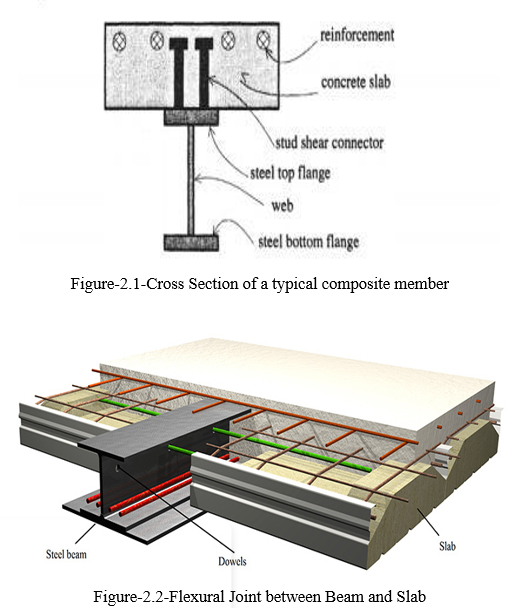
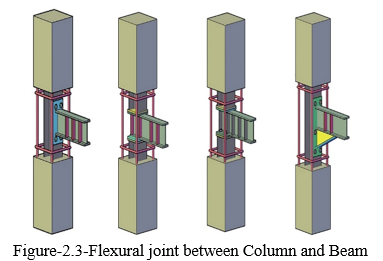
???????A. Advantages Of Composite Structure
- Increase strength for a given cross-sectional dimension.
- Increased stiffness, resulting in reduced slenderness and increased resistance to warping.
- Good fire resistance in case of encased concrete.
- Corrosion protection in coated elements.
- Outstanding seismic performance for lateral loads.
- Substantial economic advantage over alternatives to purely steel or reinforced concrete structures.
- This allows the external dimensions of the column to be kept fixed over several floors of the building, thus simplifying construction and architectural details.
- Build a high-rise building in an extremely efficient way.
- No formwork is required for the concreting tubular section. Economical for high-rise buildings.
III. MODELLING AND ANALYSIS
This chapter explained that the 3D building model is analyzed using the Response Spectrum method. The commercial building models G+25 RCC and Composite are analyzed using ETABS 19 software. The seismic codes are unique to a particular region of the country. In India, Indian Standard for Design of Seismic Structures IS 1893:2016 is the main standard that provides the outline for the calculation of seismic design forces.
- Model 1: G+25 RCC Structure of Uniform Section
- Model 2: G+25 RCC Structure of Optimized Section
- Model 3: G+25 Composite Structure of Uniform Section
- Model 4: G+25 Composite Structure of Optimized Section
A. Optimization
The process of finding the best economic structural outcomes with maximum benefit at minimum material or cost is called optimization. Due to recent advances in structural design, it is very easy to obtain a safe design, but difficult to find an economical design, so optimization techniques are needed to obtain most economically efficient design.
This is beneficial in many ways such as saving materials, reducing concrete usage. Therefore, optimization has gained momentum in structural engineering. In this project, optimization of columns and beam is carried out.
B. Step Of Section Optimization
- First define various section of column and beam both for RCC and composite structure.
- Start assigning from minimum section to the column or beam and run analysis, after analysis check for design if design check meets the demand capacity ratio, then section is safe for structure, if not then increase the section and repeat the process till design check satisfy the demand capacity ratio.
- After satisfy demand capacity ratio for uniform section, then check for stress level in each column and beam. Some column and beam just pass the design check and some are under stressed.
- According to stress level in column and beam assign lower section and run analysis, after analysis check for design, if design check meets the demand capacity ratio, then section is safe for structure. If not then repeat this process till stress level meet the demand capacity ratio.
- After all the column and beam match the approximate same demand capacity ratio, the section come out by this iterative process is now optimized section for structure.
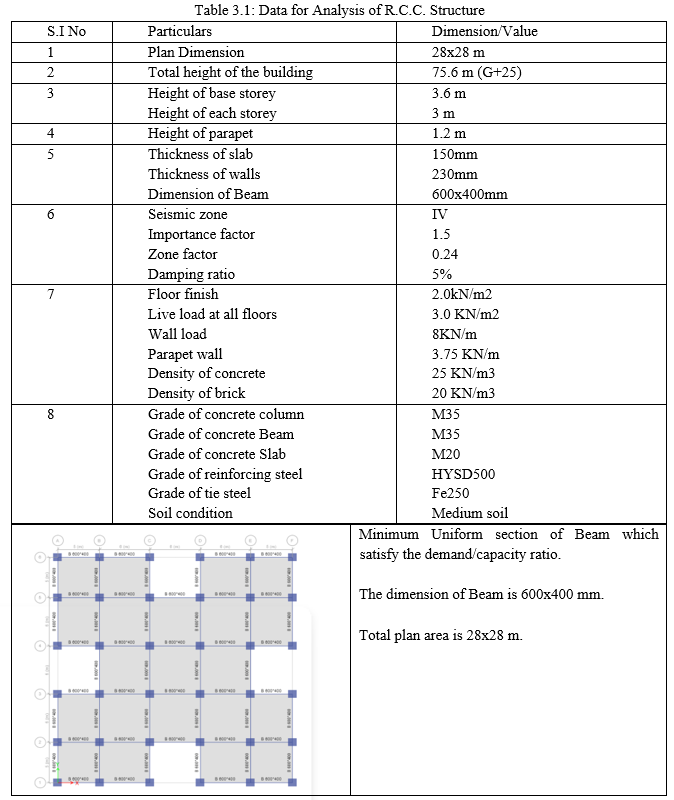
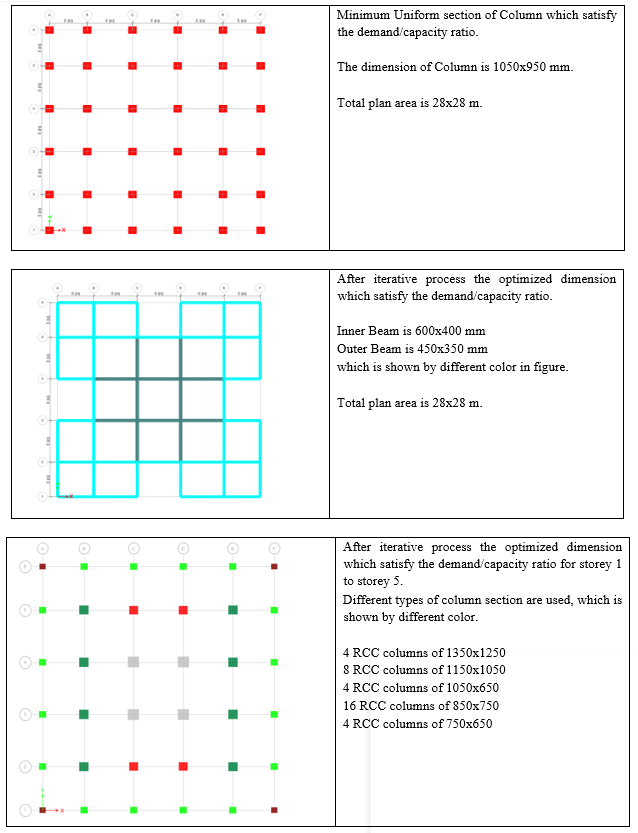



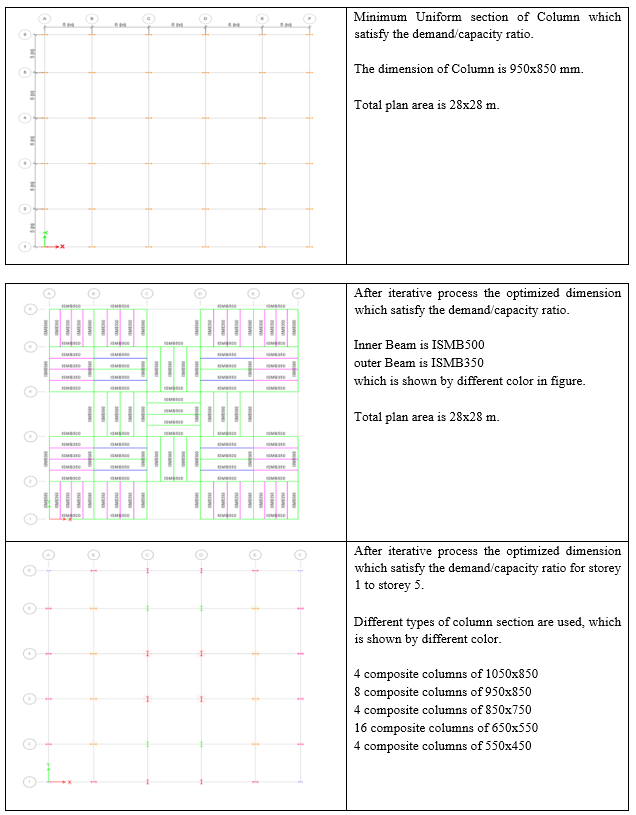
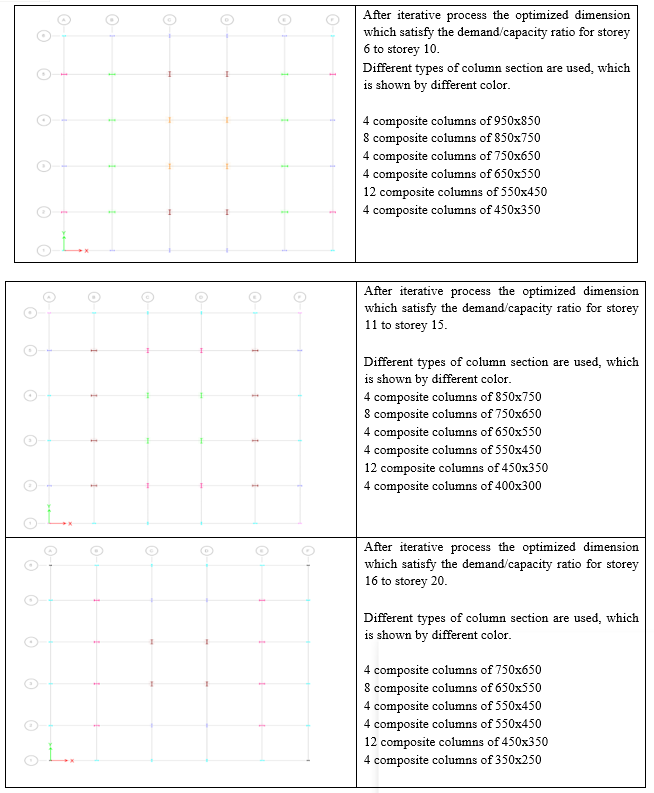
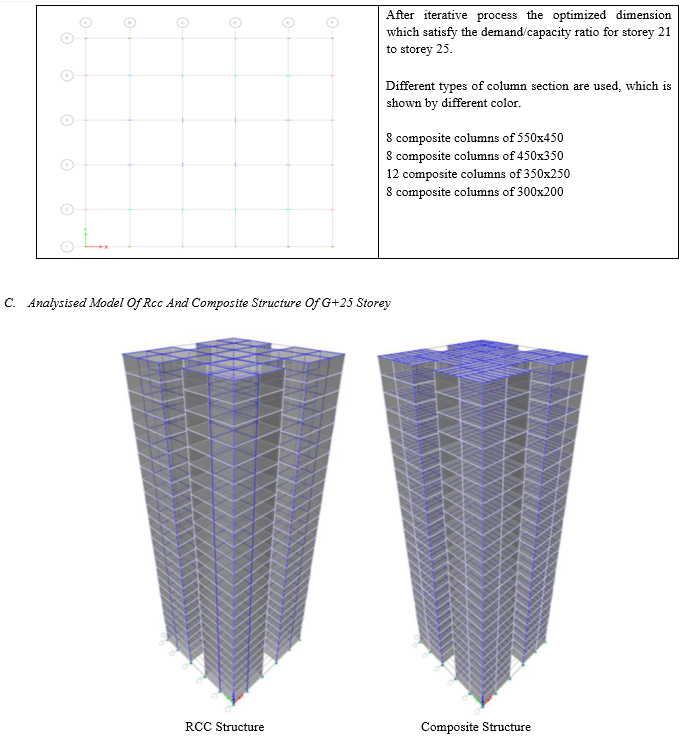
IV. RESULT
The Dynamic Analysis is conducted on two different model using CSI ETABS19, several values ??of model were found out from RCC and Composite Structure. IS 1893-2016 guidelines is used for the Dynamic Analysis of four model of G+25 storey. these structures are analyzed for RCC and Composite Structure of uniform and optimized section.
Therefore, total four models are used for analyzing the response of the building. The result of frequency, time period, displacement, drift, storey shear, storey overturning moment and storey stiffness are compared for both RCC and Composite structure of uniform and optimized section.
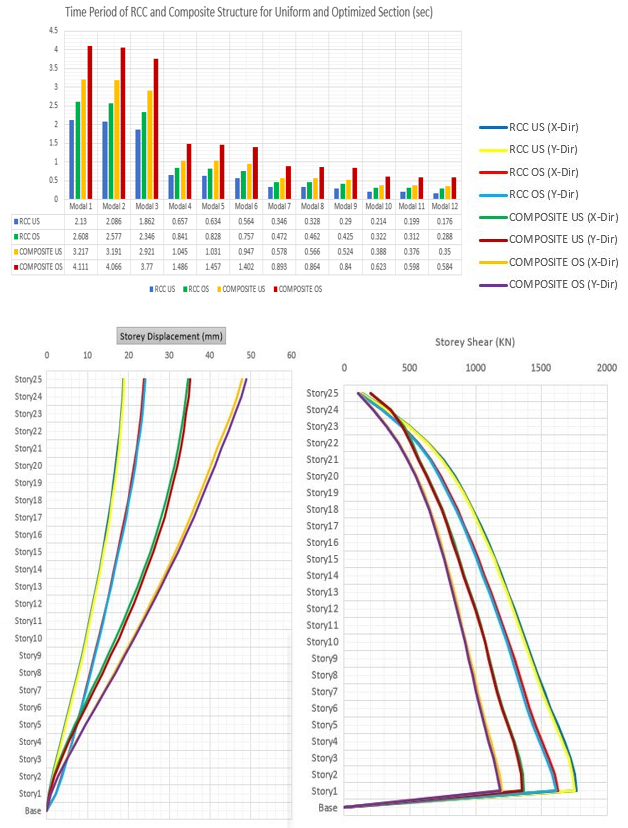
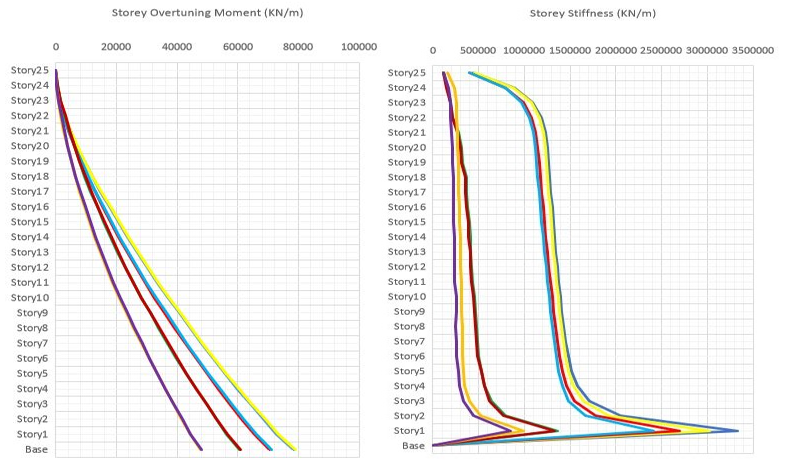 ???????
???????
Conclusion
A. Time Period 1) After optimization of RCC structure, time period increased by 22.4% as compare to uniform RCC section. 2) In a similar manner, time period increased by 28.6% for optimized section of composite structure as compare to uniform composite section. B. Storey Displacement 1) Maximum storey displacement increased by 28.2%.for optimized RCC section with respect to uniform RCC section. 2) In a similar manner, maximum storey displacement increased by 40.7% for optimized section of composite structure as compare to uniform section. C. Storey Stiffness 1) After optimization of RCC structure, storey stiffness decreased by 27.8% as compare to uniform RCC section. 2) In a similar manner, storey stiffness decreased by 37.9% for optimized section of composite structure as compare to uniform composite section. D. Storey Shear 1) Maximum storey shear decreased by 9.1%.for optimized RCC section with respect to uniform RCC section. 2) In a similar manner, maximum storey shear decreased by 13.2% for optimized section of composite structure as compare to uniform composite section. E. Storey Overturning Moment 1) In case of Uniform Section to optimized section for RCC, maximum storey overturning moment decreases by 10.9%. 2) In a similar manner, Uniform Section to optimized section for composite structure, maximum storey overturning moment decreases by 21.5%. F. Future Scope In this paper it is shown that RCC and Composite structures are compared in various aspects under uniform and optimized conditions. But found that Fire protection is very important in case of steel or composite structure. it can lead to change the design criteria such as thickness of slab, nominal cover of composite column etc. and other thing is soil conditions it can be changed other than hard soil and can be compared for worst conditions. in India generally these aspects are not considered fully. But practical applications of these comparison can make structure more safe and more economical. Also, more accurate comparison processes and aspects can be developed. Study can be held on comparison of RCC structure with sear walls and bracing in deferent locations against Composite structure with sear walls and bracing in same location. The researchers can use deferent software and then compare results and state that which software is more effective.
References
[1] D.R. Panchal and P.M. Marathe. December, 2011. “Comparative Study of RCC, steel and composite (G+30 storey) Building”, ICCTT. [2] Renavikar Aniket V, Suryawanshi Yogesh. July, 2013. “Comparative study on analysis and cost of RCC and steel composite structure”. ISSN: 2319-7064, Volume 5, Issue 7, IJSR. [3] Shashikala. Koppad, Dr. S.V.Itti. November, 2013. “Comparative Study of RCC and Composite Multistoreyed Buildings”. ISSN: 2277-3754, Volume 3, Issue 5, IJEIT. [4] Zafar Mujawar, Prakarsh Sangave, January, 2015. “Comparative Evaluation of Reinforced Concrete, Steel and Composite Structure under the Effect of Static and Dynamic Loading”. ISSN: 2248-9622, Volume 5, Issue 1, IJERA, Pg.no:41-44. [5] Prakarsh Sangave, Nikhil Madur, Sagar Waghmare, Rakesh Shete, Vinayak Mankondi, Vinayak Gundla. February, 2015. “Comparative study of Analysis and Design of RC and steel structure”. ISSN: 2229-5518, Volume 6, Issue 2, IJSER [6] Sattainathan.A, Nagarajan.N. March, 2015 “Comparative study on the behavior of RCC steel and composite structure (B+G+20 storeys)”. ISSN: 2395-3837, Volume 1, Issue 3, IJACEE, Pg.no:21-26. [7] Swapnil B. Cholekar, Basavalingappa S. M, July-2015. “Comparative analysis of Multistoried RCC and composite building due to mass irregularity”, ISSN: 2395-0072, Volume 2, Issue 4, IRJET. [8] Varsha Patil, Shilpa Kewate, August-2015 “Comparative study on dynamic analysis of composite RCC and steel structure”. ISSN: 2349-4476, Volume 3, Issue 8, IJETMAS. [9] VISHWAS J, CHANDRASHEKAR A R, CHETAN GONNI S “Comparative study of RCC and structural steel-concrete composite frame from Linear and Non-Linear Analysis”. ISSN: 2395-0072, Volume 4, Issue 7, IRJET. [10] Gorakh Vinit, Nishit Kadia, Kiranmoy Samanta, October-2018. “Comparative study of RCC and steel structure for different floor heights”. ISSN: 2349-2163, Volume 5, Issue 10, IJIRAE. [11] Jyothi D N, February-2018 “Comparative Analysis of RCC and Steel structure”. ISSN: 23950072, Volume 5, Issue 2, IRJET. [12] Pallavi Harish Wagh, Dr. S. K. Kulkarni, Vishwajeet Kadlag, 2019. “Comparative Study on Analysis and Design of RCC and Composite Structure”, ISSN: 2454-132X, Volume 5, Issue 3, IJARIIT. [13] Samadhan jagadale, M.R. Shiyekar, Y.M. Ghugal. July-2019 “Comparative study of Steel, RCC and composite frame building”. ISSN: 2395-0072, Volume 6, Issue 7, IRJET. [14] Dr. D. R. Panchal Int. Journal of Engineering Research and Applications ISSN: 2248-9622, Vol. 4, Issue 7(Version 2), July 2014, pp.124-138 [15] Kentan Patel, Sonal Thakkar. 2019 “Analysis of CFT (Concrete Filled Steel Tube), RCC and steel building subjected to lateral loading”, ELSEVIER. [16] Anil S.Savadi, Dr. Vinod Hosur. “Comparative study of RCC, steel and composite structures for industrial building”. ISSN: 2395- 4396, Volume 5, Issue 4, IJARIIE. [17] MOHD AMIR KHAN Comparative Study of R.C.C & Structural Steel -Concrete Composite Frame for Linear and Non-Linear Analysi [18] MOHAMMED IMRAN, SHAIK ABDULLA, S.M. HASMI ‘COMPARATIVE ANALYSIS OF REINFORCED CONCRETE & COMPOSITE STRUCTURES SUBJECTED TO STATIC & DYNAMIC LOADS’ [19] Muhammed Sabith K, Dr. Sabeena M. V. ‘Seismic Analysis of Irregular Composite Structures with Shear Connectors using ETABS’ [20] MUSTAFA M. WAGH “A REVIEW ON COMPARATIVE STUDY OF COMPOSITE RCC AND STEEL STRUCTURE\" [21] Bhavin H. Zaveri, Bhargav K.Panchotiya, Smit U. Patel, Parametric study of RCC, steel and composite structures under seismic loading, International Journal of Civil Engineering and Technology, pp. 127–147 July-August 2016. [22] Renavikar Aniket V.1, Suryawanshi Yogesh, Comparative Study on Analysis and Cost of R.C.C. and Steel-Composite Structure International Journal of Science and Research (IJSR) Volume 5 Issue 7, July 2016. [23] Manjari Blessing B, Gayathri S, Comparative Analysis of CFST and RCC Structures Subjected to Seismic Loading, International Journal of Chemtech Research Vol.10 No.8, pp 409-416, 2017. [24] Er. Tushar Loya, Er. Ravindra Bansode, Dr. M.R. Shiyekar ‘Comparative Study on Analysis and Design of Steel Building and Conventional RC Building’ [25] Abhishek Sanjay Mahajan, and Laxman G. Kalurkar. 2016. “Performance Analysis of RCC and Steel Concrete Composite Structure Under Seismic Effect.” International Journal of Research in Engineering and Technology 05 (04): 73–76. https://doi.org/10.15623/ijret.2016.0504015. [26] Balachandra G Achari, and Ravi Kiran. 2018. “COMPARATIVE STUDY ON VERTICAL IRREGULAR COMPOSITE STRUCTURE WITHRCC STRUCTURE.” [27] Agrawal, Aditya, Aditya Sharma, and Mukesh Pandey. 2020.“Review Paper on Seismic Analysis of RCC and Steel Composite Building” 3 (4): 504–8. [28] Abdul Qahir Darwish ‘A Review on Steel Concrete Composite Structures’ [29] Syed Fahad Ali, S. A. Bhalchandra 2015. “Study on Seismic Analysis of RCC and Steel-Concrete Composite Structure and Cost Comparison with Different Support Conditions” 3 (09): 354–59. [30]Dr. Ramakrishna Hegde, Mr. Bhavani shankar, Mohammed Farooq ‘PARAMETRIC STUDY OF RCC, STEEL AND COMPOSITE STRUCTURES UNDER SEISMIC LOADING’ [31] Nileshkumar V. Ganwani ‘Comparative Study of RCC and Steel-Concrete Composite Building based on Seismic Analysis’ [32] Mathew, Linda Ann. 2017. “Contrast of Seismic Behavior of R. C. C. and Composite Columns in G + 15 Storied Buildings with GFRG Infill” 6 (06): 610– 13. [33] Shweta A. Wagh*, Dr. U. P. Waghe** ‘Comparative Study of R.C.C and Steel Concrete Composite Structures’ [34] Namratha, N, M Ganesh, and B Spandana. 2018. “COMPARATIVE STUDY ON THE SEISMIC BEHAVIOUR OF RCC AND STEEL-CONCRETE COMPOSITE FRAME STRUCTURES,” 1488–95. [35] Nethravathi, S M, and T Thouseef. 2017. “Performance Analysis of Regular and Irregular Structure Under Seismic Effect for RCC and Steel Composite Column Using Response Spectrum,” no. 8: 2–6. [36] Panchal, D. R. 2014. “Advanced Design of Composite Steel-Concrete Structural Element.” Jornal of Engineering Research and Applications 4 (7): 124– 38. [37] Parasiya, Ashik S., and Paresh Nimodiya. 2013. “Review Article A REVIEW ON COMPARATIVE ANALYSIS OF BRACE FRAME WITH CONVENTIONAL LATERAL LOAD.” International Journal of Advanced Engineering Research and Studies III (I): 88–93. [38] Patel, Ketan, and Sonal Thakkar. 2013. “Analysis of CFT, RCC and Steel Building Subjected to Lateral Loading.” Procedia Engineering 51 (NUiCONE 2012): 259–65. https://doi.org/10.1016/j.proeng.2013.01.035. [39] Rathod, Sunil, Swati Sham Bhokare, Aniket Arun Shivatare, Pradip Sanjay Dhiwar, Swapnil Maruti Sathe, Rajesh Navnath Shinde, and Ug Student. 2017.“Comparative Pushover Analysis of Rcc, Steel and CompositeHigh Rise Building Frame (G+11) By Using Etabs” 17 (2): 975–6744. [40] Shah, Sumit, and S Saranya. 2020. “Comparative Study of Reinforced Cement Concrete (RCC) and Steel Structure” 9 (1): 2018–21. https://doi.org/10.21275/ART20204384. [41] Shariff, Faizulla Z, and Suma Devi. 2015. “Comparative Study on RCC and Cft Multi-Storeyed Buildings.” International Research Journal of Engineering and Technology (IRJET), 1812–17. [42] Sutar, S.R., and P.M. Kulkarni. 2016. “Comparative Inelastic Analysis of RCC and Steel-Concrete Composite Frame.” IOSR Journal of Mechanical and Civil Engineering 13 (04): 22–32. https://doi.org/10.9790/1684-1304042232. [43] Anamika Tedia, and Dr. Savita Maru. 2014. “‘Cost, Analysis and Design of Steel-Concrete Composite Structure Rcc Structure.’” IOSR Journal of Mechanical and Civil Engineering 11 (1): 54–59. https://doi.org/10.9790/1684-11125459. [44] Vaseem, M.D., and Dr.B.R. Patagundi. 2016. “Comparison between R.C.C and Steel Structures by Seismic Analysis.” Bonfring International Journal of Man Machine Interface 4 (Special Issue): 134–40. https://doi.org/10.9756/bijmmi.8170. [45] Zaveri, Bhavin H., Bhargav K. Panchotiya, Smit U. Patel, and Pratik A. Bilimoria. 2016. “Parametric Study of RCC, Steel and Composite Structures under Seismic Loading.” International Journal of Civil Engineering and Technology 7 (4): 127–47.
Copyright
Copyright © 2022 Ankit Kumar, Dr. Savita Maru. This is an open access article distributed under the Creative Commons Attribution License, which permits unrestricted use, distribution, and reproduction in any medium, provided the original work is properly cited.

Download Paper
Paper Id : IJRASET39503
Publish Date : 2021-12-18
ISSN : 2321-9653
Publisher Name : IJRASET
DOI Link : Click Here
 Submit Paper Online
Submit Paper Online

